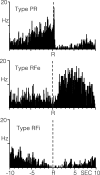Selective encoding of cocaine versus natural rewards by nucleus accumbens neurons is not related to chronic drug exposure
- PMID: 14657180
- PMCID: PMC6741056
- DOI: 10.1523/JNEUROSCI.23-35-11214.2003
Selective encoding of cocaine versus natural rewards by nucleus accumbens neurons is not related to chronic drug exposure
Abstract
We reported previously that subsets of nucleus accumbens (Acb) neurons differentially encode information about goal-directed behaviors for "natural" (food and water) versus cocaine reward in animals well trained to self-administer the drug (Carelli et al., 2000). Here, we examined whether repeated exposure to cocaine is the crucial determinate of the selective encoding of cocaine versus water reinforcement by Acb neurons. Acb cells were recorded during a water-cocaine multiple schedule from the first day of cocaine exposure as well as during repeated sessions. Specifically, animals were initially trained to press a lever for water and were then surgically prepared for extracellular recording in the Acb. After 1 week, Acb cells were recorded during acquisition of the water-cocaine multiple schedule. Because behavioral responding for water was already established, training on the multiple schedule was divided into three components corresponding to acquisition of self-administration: (1) "initial" (day 1 of self-administration), (2) "reliable" (self-administration behavior was present but erratic), and (3) "stable" (cocaine responding was stable). During the initial component, the percentage of water-selective neurons was high compared with cocaine neurons. However, this became approximately equal with repeated self-administration experience (i.e., during the stable component). Remarkably, the percentage of neurons showing overlapping (similar) neuronal firing patterns during initial exposure to cocaine was low (<8%) and remained low during reliable and stable components. These findings support the view that separate neural circuits in the Acb differentially encode information about cocaine versus natural reward, and that this functional organization is not a direct consequence of chronic drug exposure.
Figures








References
-
- Alexander GE, Crutcher MD ( 1990) Functional architecture of basal ganglia circuits: neural substrates of parallel processing. Trends Neurosci 13: 266-271. - PubMed
-
- Alexander GE, DeLong MR, Strick PL ( 1986) Parallel organization of functionally segregated circuits linking basal ganglia and cortex. Annu Rev Neurosci 9: 357-381. - PubMed
-
- Bowman EM, Aigner TG, Richmond BJ ( 1996) Neural signals in the monkey ventral striatum related to motivation for juice and cocaine rewards. J Neurophysiol 75: 1061-1073. - PubMed
-
- Brog JS, Salyapongse A, Deutch AY, Zahm DS ( 1993) The patterns of afferent innervation of the core and shell in the “accumbens” part of the ventral striatum: immunohistochemical detection of retrogradely transported fluoro-gold. J Comp Neurol 338: 255-278. - PubMed
-
- Caine SB, Lintz R, Koob GF ( 1993) Intravenous drug self-administration techniques in animals. In: Behavioral neuroscience: a practical approach (Sahgal A., ed), pp 117-143. Oxford: Oxford UP.
Publication types
MeSH terms
Substances
Grants and funding
LinkOut - more resources
Full Text Sources
Other Literature Sources
